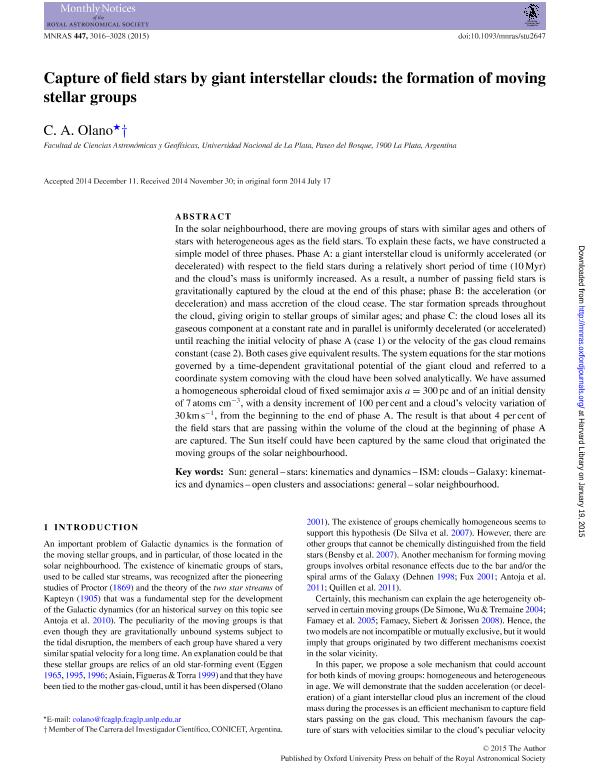Mostrar el registro sencillo del ítem
dc.contributor.author
Olano, Carlos Alberto

dc.date.available
2018-07-30T17:38:09Z
dc.date.issued
2015-03
dc.identifier.citation
Olano, Carlos Alberto; Capture of field stars by giant interstellar clouds: The formation of moving stellar groups; Wiley Blackwell Publishing, Inc; Monthly Notices of the Royal Astronomical Society; 447; 4; 3-2015; 3016-3028
dc.identifier.issn
0035-8711
dc.identifier.uri
http://hdl.handle.net/11336/53422
dc.description.abstract
In the solar neighbourhood, there are moving groups of stars with similar ages and others of stars with heterogeneous ages as the field stars. To explain these facts, we have constructed a simple model of three phases. Phase A: a giant interstellar cloud is uniformly accelerated (or decelerated) with respect to the field stars during a relatively short period of time (10 Myr) and the cloud's mass is uniformly increased. As a result, a number of passing field stars is gravitationally captured by the cloud at the end of this phase; phase B: the acceleration (or deceleration) and mass accretion of the cloud cease. The star formation spreads throughout the cloud, giving origin to stellar groups of similar ages; and phase C: the cloud loses all its gaseous component at a constant rate and in parallel is uniformly decelerated (or accelerated) until reaching the initial velocity of phase A (case 1) or the velocity of the gas cloud remains constant (case 2). Both cases give equivalent results. The system equations for the star motions governed by a time-dependent gravitational potential of the giant cloud and referred to a coordinate system comoving with the cloud have been solved analytically. We have assumed a homogeneous spheroidal cloud of fixed semimajor axis a = 300 pc and of an initial density of 7 atoms cm-3, with a density increment of 100 per cent and a cloud's velocity variation of 30 km s-1, from the beginning to the end of phase A. The result is that about 4 per cent of the field stars that are passing within the volume of the cloud at the beginning of phase A are captured. The Sun itself could have been captured by the same cloud that originated the moving groups of the solar neighbourhood.
dc.format
application/pdf
dc.language.iso
eng
dc.publisher
Wiley Blackwell Publishing, Inc

dc.rights
info:eu-repo/semantics/openAccess
dc.rights.uri
https://creativecommons.org/licenses/by-nc-sa/2.5/ar/
dc.subject
Galaxy: Kinematics And Dynamics
dc.subject
Ism: Clouds
dc.subject
Open Clusters And Associations: General
dc.subject
Solar Neighbourhood
dc.subject
Stars: Kinematics And Dynamics
dc.subject
Sun: General
dc.subject.classification
Astronomía

dc.subject.classification
Ciencias Físicas

dc.subject.classification
CIENCIAS NATURALES Y EXACTAS

dc.title
Capture of field stars by giant interstellar clouds: The formation of moving stellar groups
dc.type
info:eu-repo/semantics/article
dc.type
info:ar-repo/semantics/artículo
dc.type
info:eu-repo/semantics/publishedVersion
dc.date.updated
2018-07-30T13:37:14Z
dc.journal.volume
447
dc.journal.number
4
dc.journal.pagination
3016-3028
dc.journal.pais
Reino Unido

dc.journal.ciudad
Londres
dc.description.fil
Fil: Olano, Carlos Alberto. Consejo Nacional de Investigaciones Científicas y Técnicas; Argentina. Universidad Nacional de La Plata. Facultad de Ciencias Astronómicas y Geofísicas; Argentina
dc.journal.title
Monthly Notices of the Royal Astronomical Society

dc.relation.alternativeid
info:eu-repo/semantics/altIdentifier/doi/https://dx.doi.org/10.1093/mnras/stu2647
dc.relation.alternativeid
info:eu-repo/semantics/altIdentifier/url/https://academic.oup.com/mnras/article/447/4/3016/1748816
Archivos asociados
